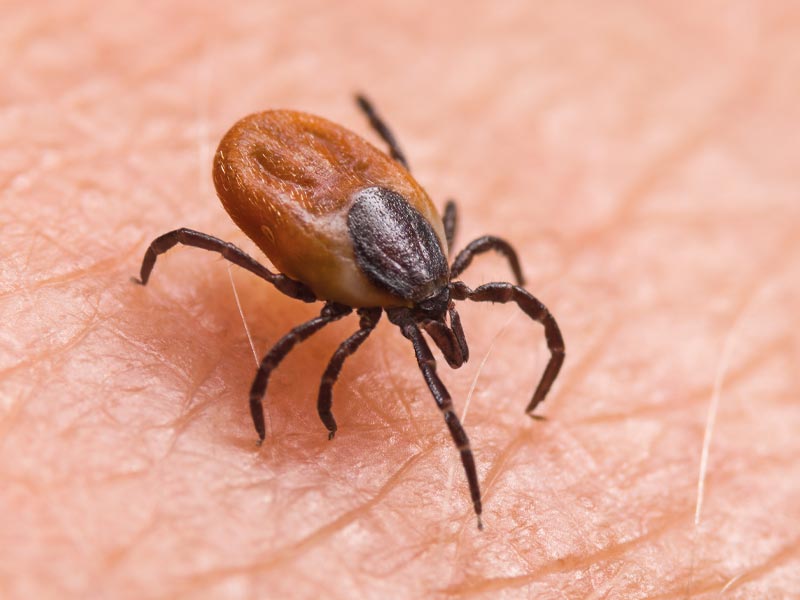Sheep Tick & Louping Ill
The increasing scourge of Grouse Moors, killing up to 85% of all Grouse chicks infected.
Louping ill kills up to 85% of all Grouse chicks infected. It is a virus which is carried by sheep tick and there are many hosts to it including red, sika, fallow and roe deer, mountain hares, sheep (obviously!), Red Grouse (but not Black Grouse) etc. There used to be a vaccine against louping ill, but this was withdrawn approximately four years ago and whilst there is a likelihood of a new vaccine being available in due course, it is not currently. Therefore, the only way that louping ill can be prevented from getting a real foothold on Moorland and potentially having a very, very adverse effect on Grouse survival and hence Grouse numbers, is for affected Moors to run a properly managed sheep flock, to effectively “mop up” the sheep tick. Without the sheep tick, louping ill cannot spread. The concept is very simple for mopping up tick; doing it is much harder! Essentially it needs the right number of sheep, spread out all over the Moor, literally coming into contact with the tick, which are then killed because the sheep have been treated with an acaricide, usually Dysect but sometimes Crovect or a wet dip such as Golden Fleece.
Although louping ill was a major problem in many areas of the north of England and Scotland at the end of the 19th and early 20th century, compulsory dipping of sheep to prevent sheep scab and the fact that dips prior to 1984 were organophosphate based, which were incredibly effective at killing tick (but sadly a lot else besides), meant that tick numbers were very low almost everywhere. However, when these dips were banned, which very often was at a similar time to when Scottish Grouse Moor owners and Keepers in particular thought that sheep were bad on Grouse Moors and therefore by removing sheep from the hills, Grouse would improve. What actually happened was that sheep tick numbers dramatically increased and as a result, louping ill spread. On Moors which have a high incidence of louping ill, there is usually no shootable surplus of Grouse. It is therefore essential that where there is louping ill, particularly where it is in the early stages (low density), a proper and sustained programme of getting on top of sheep tick and as a consequence limiting the spread of louping ill, is put in place. Failure to do so quickly and completely, will enable ticks and the spread of infection to “expand” at a compounded rate, such that over three or four years, it can soon become a massive problem. When the whole Moor is covered with sheep ticks and louping ill is as a result spread across it, trying to sort this out becomes extremely difficult and potentially, almost impossible. This is made worse north of the Border, by the high density of deer and by the protection that the Scottish Government has recently given to mountain hares. Both these make controlling tick that much harder.
Most English Moors never saw sheep tick as a real issue until a few years ago. Whilst places like the Trough of Bowland and the North York Moors have had tick and louping ill for a long time, this was generally at quite a low level. The main Pennine chain has overall been farmed with quite high numbers of sheep and as a result, low tick numbers and very little louping ill. That is now all changing. After foot and mouth in 2001, many upland sheep flocks were culled and replacement sheep were brought in, without the Farmers knowing whether these sheep were infected with louping ill. We are now seeing louping ill on Moors from the Peak District up to the Scottish Border and with the real likelihood that this situation is only going to get worse. We first came across louping ill on the North York Moors at the end of the 1990s. Since then, we have worked with it on a large number of Moors in Scotland from the Highlands down to the Borders and more recently, in the north of England. What we have found is that unless the sheep programme is done to an exceptionally high standard, with the right number of sheep on the Moor (not Natural England’s assessment), and that those sheep are both properly treated with acaracide, usually six to seven times per year, as well as being actively shepherded over the hill, there will be no significant reduction in tick numbers and whatever treatment is currently occurring, will fail to be at all cost effective.
We have recently come across a Moor which has been treating their sheep with an acaricide two to three times a year; this is hopeless and probably is almost a complete waste of money.
If you do not know if louping ill is present on your Moor, but Grouse chicks die without the obvious cause being predation or adverse weather, then it is most likely that louping ill is there. If so, you need to active swiftly and decisively.
We at JM Osborne Rural & Sporting would be delighted to help you with any advice you might need on this subject.
Please get in contact on 01295 277197 or by email at info@jmosborne.co.uk



